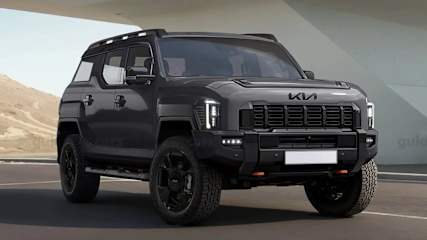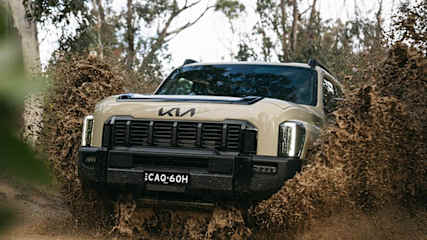Kia Tasman News
.jpg)
Is Kia Tasman better with aftermarket kit?
Read the article
By Marcus Craft · 24 Dec 2025
The Kia Tasman has made its mark.In the slow-burn lead-up to the launch of Kia’s new ute there were doubters, haters and those who were simply nonplussed about the whole thing.It didn’t help that Kia’s ad campaign – which tapped into Australia’s love of sporting icons and starred the likes of Ash Barty, Dylan Alcott, Steve Waugh and numerous others – left a lot of Aussies feeling decidedly unexcited about the launch of the new ute.But surely UFC world featherweight champion Alex Volkanovski, who featured in the ad, didn’t back a dud, did he? Of course, he didn’t.The Kia Tasman is a body-on-frame 4WD with a ladder chassis, rear diff lock (mechanical in all 4WD Tasmans, except the top-spec which has an electronic rear diff lock) and off-road drive modes. It has the latest-generation all-aluminium Smartstream 2.2-litre four-cylinder turbo-diesel engine – producing 154kW at 3800rpm and 440Nm from 1750-2750rpm – and that’s paired with an eight-speed automatic transmission. It’s not a hardcore 4WD as is, but the Tasman has ample appeal as a daily driver and that’s ultimately far more important than its 4WD capabilities.In terms of engine and transmission, useable power and torque output, effective driver-assist technology and overall off-road performance, the Tasman is very impressive.Kia may have experienced a slower-than-hoped start to sales of its ute but the Tasman is an intriguing entry in the dual-cab ute market: it’s a premium utility vehicle and at the very top of the class in terms of refinement, comfort and all-around driveability. Attention to detail is impressive, build quality is great, and everything inside and outside of the cabin looks and feels premium.Sure, it could do with more power and torque but it performs ably with what it has. This is an impressive all-round package – functional, comfortable and capable – and it’s a decent 4WD for light-to-moderate off-road touring straight out of the dealership.It can actually tackle reasonable-use off-road scenarios without compromising any of its day-to-day useability and, as such, it’s a strong indication of just what future 4x4s should be like.But to enhance its off-road potential even more, you’ll either opt for some of Kia’s genuine accessories or you’ll tap into the lively Australian off-road aftermarket industry.Kia’s genuine accessories range from tailored rubber floor mats, roadside assist kit and matt black bonnet protector through to a roof rack packing kit, towball-mounted three-bike carrier and electric roller shutter cover.So, why is the Tasman so well suited to an ongoing positive collaboration with our 4WD aftermarket industry? Well, it’s ripe for enhancement, that’s why.For one, Tasman owners can cover up the front end that so many naysayers and style masters have been complaining about – apparently they’re not at all keen on the Tasman’s wide-set headlights. According to those same people, the Tasman either has a ‘face’ only a mother could love, or a ‘face’ that is inherently punchable.Easily fixed. Throw on a bullbar (maybe a Summit MKII from ARB, which doesn’t affect the driver-assist safety systems), a UHF antenna mount, front recovery points and an LED light bar to disguise the nose, as well as, a bit further back, a snorkel (for those pesky creek crossings).And the good news there’s a whole lot more where that came from as top-notch Aussie aftermarket companies such as ARB have led the charge here with a full range of accessories for the Tasman, designed and engineered to make the Kia ute even better off-road than it is as standard.Start off with essential gear such as that aforementioned snorkel and a set of aggressive all-terrain tyres.The Taman’s standard suspension – double wishbone and coil springs upfront, live axle and leaf springs at the rear – is a traditional ute set-up made for heavy loads, but it’s better tuned for a softer, more compliant ride, even unladen, on all surfaces.But it can always be improved: get some aftermarket suspension, a new leaf pack tuned to suit your load-carrying requirements wouldn’t go astray, and a GVM (gross vehicle mass) upgrade while you’re at it.In terms of off-road angles the Tasman does well, especially the X-Pro with approach (32.2 ), ramp-over (25.8), and departure (26.2) angles that are better than standard, especially for a ute with a long wheelbase. It has 252mm of ground clearance and a listed wading depth of 800mm, which is plenty on both counts. However, under-vehicle protection is crucial to shield the vehicle’s vital components (think control arms, sump, transfer case and more) from damaging rock strikes while you steer your Tasman through challenging terrain on your way to Adventure Town! … or at least Bundaberg.For touring and storage, the aftermarket can provide the Tasman with an alloy canopy over the tub to keep your camping gear or work tools secure from thieves and protected from the elements if the weather turns ugly.That same canopy may have a spare wheel carrier at the rear if you so desire and a foldaway ladder so you can access your roof-top tent or whatever camping gear you have stowed away up top on the cargo platform atop the canopy.If your Tasman doesn’t come out of the factory equipped with side steps – as is the case with the top-shelf X-Pro variant – you can treat yourself to some of those (replete with anti-slip tread plates) and also get a set of sturdy side rails to protect the ute’s wheel arches and panels from damage while rock-crawling.Don’t forget to include all-important vehicle-recovery gear onboard, including soft shackles, snatch strap, vehicle recovery tracks and more.There’s plenty of work you can do on – and accessories you can add to – the Tasman (or any 4WD for the matter) via Australia’s aftermarket industry, so crack open your wallet and go for it.

Big news on Kia Tasman Hybrid and SUV
Read the article
By Andrew Chesterton · 19 Dec 2025
Kia has detailed a timeline of when to expect key updates for its Tasman ute, including its long-awaited Ford Everest-fighting SUV version and a petrol-hybrid powertrain.
.jpg)
Ute heavyweights crush the competition
Read the article
By James Cleary · 11 Dec 2025
Despite a huge onslaught of fresh competition in the Australian ute market, November new car registration figures show established players continue to lead the category by a healthy margin.
.jpg)
'Mind blowing' Hyundai ute launch date
Read the article
By Stephen Ottley · 04 Nov 2025
Explosive details on new Hyundai ute

Kia Tasman is the future of 4x4s | Opinion
Read the article
By Marcus Craft · 02 Nov 2025
Kia's Tasman might be controversial - but here's why it might actually be the future of 4x4s

Has Kia just shown off the new-look Tasman?
Read the article
By Dom Tripolone · 25 Oct 2025
Kia might be preparing a fresh face for its Tasman workhorse ute.Debate about the Tasman’s styling has followed it around like a bad smell since the day it was revealed. That might be all about to change.Kia recently revealed a military-grade Tasman as part of its display at the International Aerospace & Defence Exhibition in Seoul.The show cars were the usual military fare, but Kia’s Special Vehicle division showcased several suggested uses for the military-grade Tasman on its website.The hard to access website - we had to go incognito mode to get it to load — looks just like any Kia retail page but has heavy duty Tasmans.A few images jumped out, with a 'Military Command Vehicle' and a 'Military Version Pick-up truck' showing a substantially different look to the current Tasman.These images are clearly computer generated, but so are the rest of the images on this official Kia website that all depict the current shaped Tasman.This might be a long bow, but it is also odd they would publish these images that look so obviously different.The digital renders show a new headlight design, completely new fender flares front and back and an altered grille, bonnet and front bumper.The result is tough and — dare I say — handsome ute. Kia has not confirmed to CarsGuide if these images are real or not.Kia’s global VP of Next Interior Design, Jochen Paesen, previously said people will get used to the design, which was intended to stand out from the outset.“This is really, really important for Kia, we want to make sure that we have a clear identity. It does stand out. We are new to the market. It needs to be noticed. And generally, and this is generally for design, if you want to be progressive, if you want to stand out, if you want to do something new, you will go through a process of getting people used to it,” he said.The proof is in the sales figures.Despite receiving critical acclaim for how the car actually performs on and off the road, sales of the Tasman haven’t moved the needle.Kia is currently moving about 800 Tasmans a month, which is about half of what it needs to hit its lofty targets.A new look could catapult way up the charts.
.jpg)
Military-spec Tasman revealed!
Read the article
By Tom White · 21 Oct 2025
The tough Kia Tasman overhaul you weren't expecting
_0.jpg)
Is this new ute in trouble already?
Read the article
By Chris Thompson · 14 Oct 2025
A limited-time offer on the Kia Tasman could be a sign the brand is trying to boost early sales of the ute to get closer to its lofty sales goal.
.jpg)
Kia Tasman hybrid closer than we thought!
Read the article
By Andrew Chesterton · 11 Oct 2025
Kia appears to have solved its biggest hurdle in bringing a Tasman Hybrid to market, with what appears to be a rear-drive version of the company's 2.5-litre turbo-hybrid powertrain spied testing in Europe.
.jpg)
Major Kia Tasman change coming
Read the article
By Andrew Chesterton · 04 Oct 2025
We have just gotten our first proper look at the powertrain that will likely propel the Kia Tasman out of the diesel era, with heavy reporting that the brand is plotting a 2.5-litre petrol-hybrid powertrain for its dual-cab ute in 2026.





